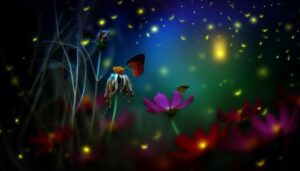Can Light Cause the Butterfly’s Wings to Glow? Yes!
Yes, light can make butterfly wings appear to glow. Butterfly wings have intricate nanostructures made of chitin that interact with light through reflection, refraction, and diffraction.
Natural fluorescence in certain organisms also contributes to their brilliant hues. Scientists have confirmed these phenomena through controlled lab experiments, offering valuable insights into the underlying mechanisms.
Understanding this, you may find even more fascinating details about how butterflies use these effects in nature. For example, some species have evolved wing structures that manipulate light to create vivid colors, helping them attract mates or evade predators. Additionally, researchers have studied how butterflies flying in hurricanes manage to navigate turbulent winds, revealing insights into their remarkable resilience and adaptability. These discoveries contribute to our understanding of both biological survival strategies and potential applications in engineering and design.

Key Takeaways
The Science of Butterfly Wings
At the microscopic level, butterfly wings are covered with tiny scales that interact with light in complex ways. Each scale consists of intricate nanostructures that can affect light’s behavior, such as its reflection, refraction, and diffraction.
You’ll find that these scales are arranged in overlapping rows, much like roof shingles, optimizing their interaction with light. The scales are composed of chitin, a polymer that affects how light is absorbed and reflected.
Structural Coloration Explained
Structural coloration in butterfly wings arises from the intricate interplay of light with the nanostructures on their scales, producing vibrant hues through mechanisms such as interference, diffraction, and scattering.
When light hits these nanostructures, it’s split into different colors, much like a prism.
The specific arrangement of these microscopic features determines the exact colors you see. Interference occurs when light waves overlap and amplify certain wavelengths while canceling others.
Diffraction bends light around the edges of these nanostructures, creating additional color effects. Scattering, meanwhile, redirects light in various directions, contributing to the intensity and richness of the colors.
This complex process is why butterfly wings can exhibit such brilliant and dynamic coloration, far surpassing what pigments alone could achieve.
Interaction With Sunlight
When sunlight strikes a butterfly’s wings, the interaction between the light and the nanostructures on the scales results in a spectacular display of color. These nanostructures, often arranged in intricate layers, cause light to reflect, refract, and diffract in specific ways.
This process, known as structural coloration, doesn’t rely on pigments but on the physical structure of the scales. You can observe vivid blues, greens, and other iridescent hues because certain wavelengths of light interfere constructively while others cancel out.
The angle of light incidence and your viewing angle can change the perceived color, making the wings seem to shimmer. This complex interaction between sunlight and wing architecture is a marvel of natural engineering, providing both beauty and camouflage.
Fluorescence in Nature
You might be surprised to learn how many organisms exhibit natural fluorescence, emitting light upon exposure to specific wavelengths. This biological light emission plays vital roles in communication, mating, and predation.
Understanding these fluorescence mechanisms reveals evolutionary advantages that have developed over millions of years.
Natural Fluorescent Organisms
Have you ever wondered how certain organisms, like jellyfish or coral, can emit a mesmerizing natural glow? These organisms owe their luminescence to a process called fluorescence.
When exposed to specific wavelengths of light, fluorescent proteins within their bodies absorb the energy and re-emit it as visible light. This can vary in color, often appearing as vibrant greens, blues, or reds.
In coral, this fluorescence plays a role in protection against harmful ultraviolet rays, essentially acting as a sunscreen. Jellyfish, on the other hand, use it for communication or predation.
The ability to fluoresce isn’t limited to marine life; some terrestrial organisms, such as certain fungi and insects, also exhibit this fascinating trait, revealing nature’s hidden spectrum of beauty.
Biological Light Emission
Fluorescence in nature is a mesmerizing phenomenon where organisms absorb light at one wavelength and re-emit it at another, often creating an enchanting display of colors. You’ll find this in various species, from jellyfish to butterflies.
When light hits these organisms, specific molecules called fluorophores absorb the energy. These fluorophores then emit light at a different, usually longer, wavelength.
This re-emission process can make a butterfly’s wings glow under ultraviolet light or cause marine creatures to light up in the ocean’s depths.
Fluorescence Evolutionary Advantages
Why do certain species evolve to exhibit fluorescence, and how does this trait confer survival advantages in their natural habitats?
Fluorescence can serve various adaptive functions. For instance, it aids in communication, enabling species to attract mates or signal distress. It can also act as camouflage, blending organisms into their bioluminescent surroundings or confusing predators.
Additionally, fluorescence may assist in foraging, as animals can use it to identify prey or navigate through environments where UV light is prevalent. In some cases, it deters predators by mimicking toxic or unpalatable species.
Lab Experiments and Findings
To investigate if light can cause a butterfly’s wings to glow, researchers conducted a series of controlled lab experiments that meticulously measured the luminescent response under various light conditions.
You’ll find the following key steps were taken to guarantee accuracy:
- Light Source Variation: Different wavelengths of light, from ultraviolet to infrared, were used to illuminate the butterfly wings.
- Sensitive Detection Equipment: Advanced photodetectors and spectrometers captured even the faintest luminescence.
- Butterfly Wing Samples: Various species were selected to determine if the glowing effect was universal or species-specific.
- Data Analysis: Researchers employed rigorous statistical methods to analyze luminescent intensity and pattern consistency.
Potential Applications
You can explore how this phenomenon could revolutionize scientific research by providing novel methods for studying insect behavior and physiology.
Additionally, you might consider its potential in environmental monitoring, where bioluminescent butterfly wings could serve as sensitive indicators of ecosystem health.
These applications promise to expand both theoretical understanding and practical tools in various scientific domains.
Scientific Research Implications
Harnessing the photonic properties of butterfly wings could revolutionize the development of advanced optical devices and materials. By studying how light interacts with these natural structures, you could discover new ways to manipulate light for various applications.
Potential benefits include:
- Optical Sensors: Enhanced sensitivity in detecting changes in light and color for medical diagnostics.
- Display Technologies: More vivid, energy-efficient screens for smartphones and televisions.
- Solar Cells: Improved efficiency in capturing and converting sunlight into energy.
- Anti-Counterfeiting Measures: Unique, hard-to-replicate security features for currency and identification documents.
Each of these areas could see significant advancements by mimicking the intricate photonic structures found in butterfly wings. Your understanding of this research can lead to innovations that are both practical and transformative.
Environmental Monitoring Tools
Butterfly wings’ unique photonic structures could serve as innovative templates for developing advanced environmental monitoring tools. You can harness these structures to detect pollutants and changes in air quality.
The wings’ ability to manipulate light at the nanoscale offers precise optical sensors for real-time data. You might integrate these sensors into wearable devices or stationary monitoring stations, enhancing their sensitivity to environmental changes.
Additionally, the natural fluorescence observed in butterfly wings can be engineered to react to specific chemical compounds, providing a visual indicator of contamination.
By adopting these biological designs, you can create more efficient and responsive tools for environmental protection, ensuring a healthier ecosystem through enhanced monitoring capabilities.
Conclusion
Imagine holding a kaleidoscope to the sun—just as it bursts with color, so do butterfly wings under specific lighting.
In lab experiments, scientists found that certain butterfly wings fluoresce, emitting a glow visible to the naked eye. These findings could inspire new materials that mimic this natural luminescence.
By comprehending the intricate dance of light and butterfly wings, we reveal possibilities for innovative designs and technologies, making nature’s wonders our blueprint for the future.






